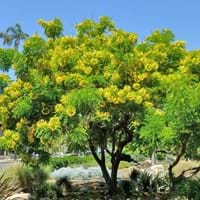Life Span
Perennial
Perennial
Type
Broadleaf Evergreen
Flowering Plants, Tree
Origin
China, Japan
Brazil
Types
Heavenly Bamboo, Nandina 'Colerno'
Dwarf Nandina 'Compacta'
Dwarf Nandina 'Filamentosa'
Heavenly Bamboo, Nandina 'Harbor Belle'
Heavenly Bamboo, Nandina 'Moon Bay'
Not Available
Number of Varieties
Not Available
Habitat
low mountains, Mountain tops, Mountains, Valley
Not Available
USDA Hardiness Zone
6-11
Not Available
AHS Heat Zone
Not Available
Not Available
Sunset Zone
21,22
Not Available
Habit
Clump-Forming
Upright/Erect
Flower Color
Not Available
Yellow
Flower Color Modifier
Bicolor
Bicolor
Fruit Color
Not Available
Not Available, White
Leaf Color in Spring
Green, Purple, Copper
Dark Green
Leaf Color in Summer
Green, Purple
Dark Green
Leaf Color in Fall
Green, Purple
Dark Green
Leaf Color in Winter
Red, Green, Purple
Dark Green
Leaf Shape
Acuminate
Pinnate
Plant Season
Spring, Summer, Fall, Winter
Spring, Summer, Fall
Sunlight
Full Sun, Partial Sun, Partial shade, Full Shade
Partial shade, Full Shade
Growth Rate
Medium
Medium
Type of Soil
Loam, Sand
Loam
The pH of Soil
Acidic, Neutral, Alkaline
Acidic, Neutral, Alkaline
Soil Drainage
Well drained
Well drained
Bloom Time
Not Available
Indeterminate, Summer
Tolerances
Drought
Drought
Where to Plant?
Ground
Ground
How to Plant?
Seedlings
Seedlings, Stem Planting
Plant Maintenance
Medium
Medium
Watering Requirements
Do not water frequently, Needs less watering
Requires regular watering
In Summer
Lots of watering
Lots of watering
In Spring
Moderate
Moderate
In Winter
Average Water
Average Water
Soil pH
Acidic, Neutral, Alkaline
Acidic, Neutral, Alkaline
Soil Type
Loam, Sand
Loam
Soil Drainage Capacity
Well drained
Well drained
Sun Exposure
Full Sun, Partial Sun, Partial shade, Full Shade
Partial shade, Full Shade
Pruning
Remove damaged leaves, Remove dead branches, Remove dead leaves
Requires very little pruning
Fertilizers
All-Purpose Liquid Fertilizer
All-Purpose Liquid Fertilizer
Pests and Diseases
Red blotch
Red blotch, Thripes
Plant Tolerance
Drought
Drought
Flower Petal Number
Not Available
Single
Foliage Texture
Fine
Bold
Foliage Sheen
Glossy
Matte
Attracts
Mealybugs, Whiteflies
Not Available
Allergy
Not Available
Not Available
Aesthetic Uses
Bonsai, Borders
Showy Purposes
Beauty Benefits
Not Available
Not Available
Environmental Uses
Air purification
Air purification
Medicinal Uses
Antirheumatic, Antitussive, Astringent
No Medicinal Use
Part of Plant Used
Fruits, Leaves
Whole plant
Other Uses
Used for making informal hedge
Used as Ornamental plant
Used As Indoor Plant
No
No
Used As Outdoor Plant
Yes
Yes
Garden Design
Container, Edging, Foundation, Groundcover, Hedges, Mixed Border, Topiary, Bonsai, Espalier
Shady Tree, Showy Tree
Botanical Name
NANDINA domestica 'Nana Purpurea'
Cassia leptophylla
Common Name
heavenly bamboo
sacred bamboo
nandina
gold medallion tree
In Hindi
Dwarf Nandina
gold medallion tree
In German
Dwarf Nandina
gold medallion tree
In French
Nandina Dwarf
gold medallion tree
In Spanish
Nandina enana
árbol medallón de oro
In Greek
Dwarf Nandina
χρυσό δέντρο μετάλλιο
In Portuguese
Nandina do anão
árvore medalhão de ouro
In Polish
Dwarf Nandina
Drzewo Medalion złota
In Latin
Dwarf Nandina
aureus arbore
Phylum
Tracheophyta
Magnoliophyta
Class
Magnoliopsida
Magnoliopsida
Order
Ranunculales
Fabales
Family
Berberidaceae
Fabaceae
Clade
Angiosperms, Eudicots
Angiosperms, Eudicots, Rosids
Tribe
Not Available
Not Available
Subfamily
Not Available
Not Available
Number of Species
Not Available
Not Available
Properties of Dwarf Nandina and Cassia Leptophylla
Wondering what are the properties of Dwarf Nandina and Cassia Leptophylla? We provide you with everything About Dwarf Nandina and Cassia Leptophylla. Dwarf Nandina doesn't have thorns and Cassia Leptophylla doesn't have thorns. Also Dwarf Nandina does not have fragrant flowers. Dwarf Nandina has allergic reactions like Not Available and Cassia Leptophylla has allergic reactions like Not Available. Compare all the properties and characteristics of these two plants. Find out which of these plant can be used as indoor plant. If you are interested to decorate your house and garden, find out aesthetic uses, compare them and select the plant which will beautify your surrounding. Along with beautification, try comparing medicinal and edible uses of Dwarf Nandina and Cassia Leptophylla and you can choose the plant having best and most benefits.
Season and Care of Dwarf Nandina and Cassia Leptophylla
Season and care of Dwarf Nandina and Cassia Leptophylla is important to know. While considering everything about Dwarf Nandina and Cassia Leptophylla Care, growing season is an essential factor. Dwarf Nandina season is Spring, Summer, Fall and Winter and Cassia Leptophylla season is Spring, Summer, Fall and Winter. The type of soil for Dwarf Nandina is Loam, Sand and for Cassia Leptophylla is Loam while the PH of soil for Dwarf Nandina is Acidic, Neutral, Alkaline and for Cassia Leptophylla is Acidic, Neutral, Alkaline.
Dwarf Nandina and Cassia Leptophylla Physical Information
Dwarf Nandina and Cassia Leptophylla physical information is very important for comparison. Dwarf Nandina height is 30.00 cm and width 60.00 cm whereas Cassia Leptophylla height is 1,300.00 cm and width 1,200.00 cm. The color specification of Dwarf Nandina and Cassia Leptophylla are as follows:
Dwarf Nandina flower color: Not Available
Dwarf Nandina leaf color: Green, Purple and Copper
Cassia Leptophylla flower color: Yellow
- Cassia Leptophylla leaf color: Dark Green
Care of Dwarf Nandina and Cassia Leptophylla
Care of Dwarf Nandina and Cassia Leptophylla include pruning, fertilizers, watering etc. Dwarf Nandina pruning is done Remove damaged leaves, Remove dead branches and Remove dead leaves and Cassia Leptophylla pruning is done Requires very little pruning. In summer Dwarf Nandina needs Lots of watering and in winter, it needs Average Water. Whereas, in summer Cassia Leptophylla needs Lots of watering and in winter, it needs Average Water.





